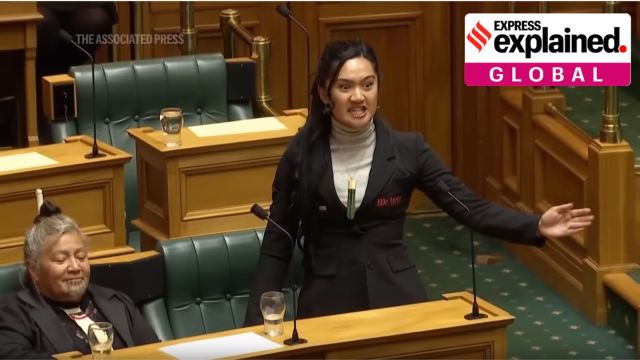Why New Zealand lawmakers staged a ‘haka’ against a divisive Bill
Lawmakers of the Indigenous Māori group staged the ceremonial dance to protest a contentious Bill, referencing a nearly 200-year-old treaty with the British Empire.
 The haka was led by Hana-Rawhiti Maipi-Clarke, a 22-year-old legislator belonging to the Te Māori (The Māori) Party. (Photo via YouTube/Associated Press)
The haka was led by Hana-Rawhiti Maipi-Clarke, a 22-year-old legislator belonging to the Te Māori (The Māori) Party. (Photo via YouTube/Associated Press)New Zealand’s parliament was briefly suspended on Thursday (November 14) following a protest by the Indigenous Māori group’s legislators, who staged a “haka” or ceremonial dance against a contentious Bill.
Hana-Rawhiti Maipi-Clarke, a 22-year-old Māori Party MP, led the haka after being asked about her party’s vote on the Treaty Principles Bill that seeks to reinterpret a 184-year-old treaty between the British and the Māori.
MPs from the opposition Māori, Green and Labour parties and people in the public gallery joined in the haka, as Maipi-Clarke tore up a copy of the Bill in front of its author. Here’s why.
What is the haka and why is it significant?
The haka is of deep cultural significance to Māori identity and is traditionally performed by warriors on the battlefield or to welcome another tribe. According to New Zealand Tourism’s website, haka “was a show of physical prowess but also an embodiment of cultural pride, strength, and unity.” It is usually performed in a group and involves chanting, dramatic facial gestures, hand movements and stamping the feet.
Most recently, the haka made global headlines in 2019 when students from various schools – including non-Māori ones – paid tribute to their peers who died in the Christchurch shootings through it.
A range of hakas are performed in Māori culture. The 19th-century tribal leader Te Rauparaha composed the Ka Mate haka staged on Thursday. With the lyrics “Ka mate, ka mate! Ka ora, ka ora!” (“I die, I die! I live, I live!”), it tells the story of his escape from his enemies and celebrates life over death.
The All Blacks, New Zealand’s rugby team, has performed the haka before each match for nearly 120 years. The tourism website says the routine gives the team “a psychological edge and elevates their heart rates above their opponents, who must stand and watch.” But traditionally, the haka has been done to show “cultural pride, strength, and unity.”
Other popular hakas include:
- Peruperu: A war haka performed before battle to intimidate the enemy and demonstrate strength.
- Ngeri: A short haka without set actions, often used to stiffen the sinews and uplift the spirit.
- Pōwhiri: A welcoming haka performed during formal greeting ceremonies.
- Manawa wera: A haka performed at funerals or memorials to express grief.
Why was the Haka performed in New Zealand’s parliament?
Despite the protest haka and a brief suspension, Thursday’s parliamentary session passed the first reading of the Treaty Principles Bill tabled by the libertarian Act Party, a minor partner in New Zealand’s centre-right coalition government.
The Bill seeks to amend the Treaty of Waitangi, the foundational document of Aotearoa (the Māori name for New Zealand). It was signed in 1840 by a representative of the British crown and 500 Māori chiefs. It promised the tribes broad rights to their lands and interests if they ceded governance to the British Empire.
Efforts have been made over the years to enshrine the core values of the treaty in the country’s laws. According to The Guardian’s report, its principles were developed over 50 years by courts, tribunals and successive governments to improve the relations between the Māori and those in power, and to improve clarity over its interpretations.
“Many principles have been developed and continue to evolve, but the most recognised are broadly defined as participation, partnership, protection, and redress,” the report said.
What is the Treaty Principles Bill?
The Bill is the brainchild of Act leader David Seymour, who said there is a need to legally define the treaty’s principles as it does not list specific principles, leading to liberal interpretations. For example, the 1975 Treaty of Waitangi Act created a tribunal for recording the horrors experienced by the Indigenous communities under colonisation.
The Act party believes the country has been “divided by race, and the Bill will allow the treaty to be interpreted more fairly through parliament, rather than the courts.” The Bill does not intend to rewrite the treaty but seeks a referendum and intends to extend it equally to all New Zealanders.
Critics say this would make the treaty pointless, threaten Māori rights and promote anti-Māori rhetoric. Even the coalition partners are not all supportive of it, including Prime Minister Christopher Luxon (who called it “simplistic”) and his New Zealand National Party. Its path to a second or a third reading may be difficult. A Māori rights group is also leading a 1,000-km-long protest march, or a hīkoi, against it to the capital Wellington.
- 01
- 02
- 03
- 04
- 05






































